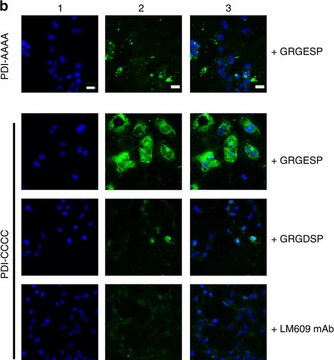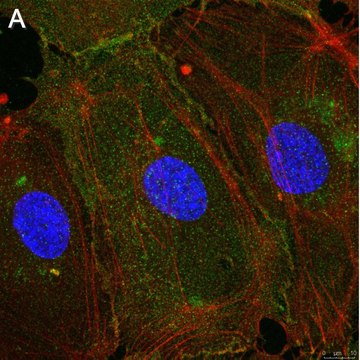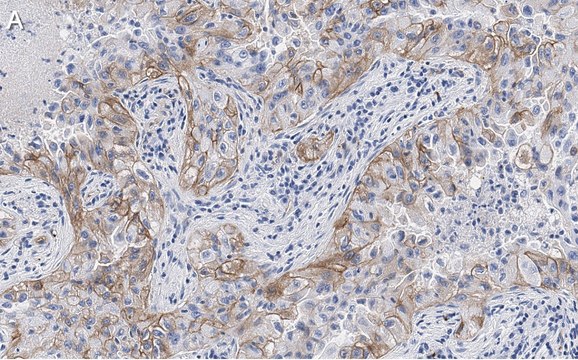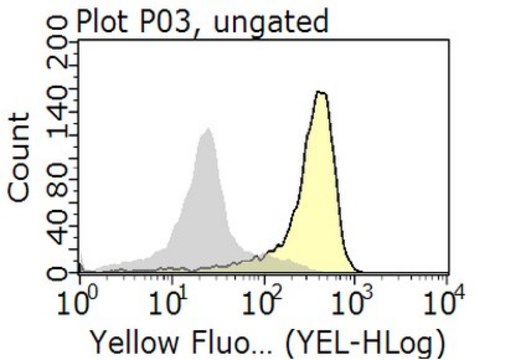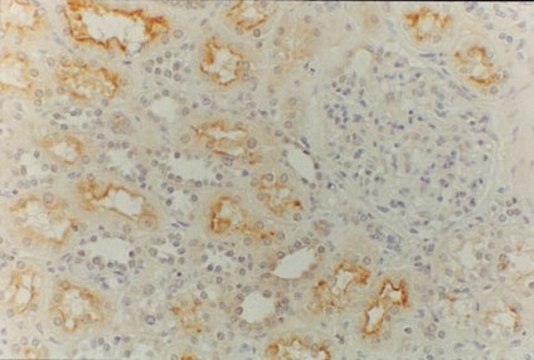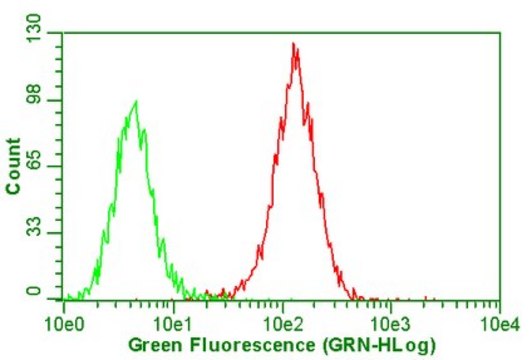MAB1976X
Anti-Integrin αVβ3 Antibody, clone LM609, Alexa Fluor™488 conjugated
clone LM609, Chemicon®, from mouse
Sign Into View Organizational & Contract Pricing
All Photos(1)
Synonym(s):
Vitronectin Receptor, CD51/61
UNSPSC Code:
12352203
eCl@ss:
32160702
NACRES:
NA.41
Recommended Products
biological source
mouse
Quality Level
conjugate
ALEXA FLUOR™ 488
antibody form
purified immunoglobulin
antibody product type
primary antibodies
clone
LM609, monoclonal
species reactivity
rabbit, monkey, canine, avian, bovine, chicken, pig, human
manufacturer/tradename
Chemicon®
technique(s)
flow cytometry: suitable
immunofluorescence: suitable
isotype
IgG1
NCBI accession no.
UniProt accession no.
shipped in
wet ice
target post-translational modification
unmodified
Gene Information
human ... ITGAV(3685)
Related Categories
General description
The integrin family of cell adhesion receptors consists of at least 16 membrane-associated heterodimers, composed of an alpha and beta subunit that associate in a non-covalent manner. The structure and functional diversity of the integrin family are based upon the pairing abilities of the individual alpha and beta subunits. Key to these molecular interactions between the integrin receptors and their respective ligands is the recognition of the Arg-Gly-Asp (RGD) sequence, known to be present in the extracellular matrix components fibronectin, vitronectin, collagen, fibrinogen, and von Willebrand factor (Cheresh, 1991). The involvement of integrins in vascular proliferation, adhesion, and wound repair has been well documented. The adhesion receptor, integrin alphaVbeta3, appears to be selectively expressed on growing blood vessels and has been identified as a marker of angiogenic vascular tissue (Brooks, 1994). Due to its involvement in angiogenesis, integrin alphaVbeta3 is one of the most intensely studied of the integrin receptors.
Specificity
Reacts with the vitronectin receptor alphaVbeta3 complex, an RGD-directed adhesion receptor. LM609 has been demonstrated to block adhesion of a human melanoma cell line (M21) to vitronectin, fibrinogen and von Willebrand factor, as well as to a synthetic RGD containing peptide (Cheresh, 1987). In chick chorioallentoic membranes, LM609 was shown to block angiogenesis induced by bFGF and TNFalpha but had no effect on pre-existing vessels (Brooks, 1994). While LM609 does block cell attachment to RGD containing ligands, it does not interact directly with the RGD binding site. Instead, LM609 appears to be an allosteric inhibitor of integrin alphaVbeta3, which binds to a conformational epitope resulting from the post-translational association of the alphaV and beta3 subunits.
Immunogen
Purified adhesion receptor from the human melanoma cell line M21 (Cheresh, 1987).
Application
Flow Cytometry: 1-3 μg LM609 per 0.5 x 10e6 cells in 100μL (Smith, 1996).Immunoprecipitation: Specifically immunoprecipitates the integrin alphaVbeta3 complex which, when resolved by SDS-PAGE under reducing conditions, results in an approximately 130 kDa band corresponding to the alphaV subunit and a 105 kDa band corresponding to the beta3 subunit (Cheresh, 1987).
Immunofluorescence: 5-10 μg/mL for staining of bFGF-treated 6 mm cryosections of chick chorioallantoic membrane fixed with acetone (Brooks, 1994). LM609 is also effective on 4% paraformaldehyde fixed, frozen tissues and cells. However it is not effective for immunohistochemical staining of paraffin-embedded tissue sections.
Inhibits adhesion of cells to vitronectin coated surfaces at 10-25 μg/mL.
Optimal working dilutions must be determined by the end user.
Immunofluorescence: 5-10 μg/mL for staining of bFGF-treated 6 mm cryosections of chick chorioallantoic membrane fixed with acetone (Brooks, 1994). LM609 is also effective on 4% paraformaldehyde fixed, frozen tissues and cells. However it is not effective for immunohistochemical staining of paraffin-embedded tissue sections.
Inhibits adhesion of cells to vitronectin coated surfaces at 10-25 μg/mL.
Optimal working dilutions must be determined by the end user.
Research Category
Cell Structure
Cell Structure
Research Sub Category
Integrins
Integrins
This Anti-Integrin αVβ3 Antibody, clone LM609, Alexa Fluor™488 conjugated is validated for use in FC, IF for the detection of Integrin αVβ3.
Physical form
Protein A purified
Purified immunoglobulin from Protein A Sepharose™ chromatography, conjugated to Alexa Fluor 488. Final formulation in PBS 0.01M, SODIUM AZIDE 0.1%, PH7.1, 15mg/mL BSA.
Storage and Stability
Maintain for 1 year at 2–8°C from date of shipment. Aliquot to avoid repeated freezing and thawing. For maximum recovery of product, centrifuge the original vial after thawing and prior to removing the cap.
Analysis Note
Control
POSITIVE CONTROL: Human myeloma cell lines M21 and MoalphaV (Chen, 1995).
NEGATIVE CONTROL: Mo cells (this cell line was derived from M21 but does not express integrin alphaV
Chen, 1995).
POSITIVE CONTROL: Human myeloma cell lines M21 and MoalphaV (Chen, 1995).
NEGATIVE CONTROL: Mo cells (this cell line was derived from M21 but does not express integrin alphaV
Chen, 1995).
Other Notes
Concentration: Please refer to the Certificate of Analysis for the lot-specific concentration.
Legal Information
ALEXA FLUOR is a trademark of Life Technologies
CHEMICON is a registered trademark of Merck KGaA, Darmstadt, Germany
Sepharose is a trademark of Cytiva
Disclaimer
Alexa Fluor™ is a registered trademark of Molecular Probes, Inc.
Unless otherwise stated in our catalog or other company documentation accompanying the product(s), our products are intended for research use only and are not to be used for any other purpose, which includes but is not limited to, unauthorized commercial uses, in vitro diagnostic uses, ex vivo or in vivo therapeutic uses or any type of consumption or application to humans or animals.
Unless otherwise stated in our catalog or other company documentation accompanying the product(s), our products are intended for research use only and are not to be used for any other purpose, which includes but is not limited to, unauthorized commercial uses, in vitro diagnostic uses, ex vivo or in vivo therapeutic uses or any type of consumption or application to humans or animals.
WGK
WGK 2
Certificates of Analysis (COA)
Search for Certificates of Analysis (COA) by entering the products Lot/Batch Number. Lot and Batch Numbers can be found on a product’s label following the words ‘Lot’ or ‘Batch’.
Already Own This Product?
Find documentation for the products that you have recently purchased in the Document Library.
Andrew J Simnick et al.
ACS nano, 4(4), 2217-2227 (2010-03-26)
Multivalency is the increase in avidity resulting from the simultaneous interaction of multiple ligands with multiple receptors. This phenomenon, seen in antibody-antigen and virus-cell membrane interactions, is useful in designing bioinspired materials for targeted delivery of drugs or imaging agents.
C Andrew Boswell et al.
Molecular pharmaceutics, 5(4), 527-539 (2008-06-10)
Ligand size and valency strongly influence the receptor uptake and clearance of tumor angiogenesis imaging agents. The structures of successful imaging agents exhibit a high degree of variability, encompassing small monovalent arginine-glycine-aspartic acid (RGD)-containing peptides, multivalent RGD-oligomers, and a monoclonal
Tanya Singh et al.
Journal of biomaterials applications, 29(3), 433-441 (2014-05-03)
The local microenvironment plays an important role in maintaining the dynamics of the extracellular matrix and the cell-extracellular matrix relationship. The extracellular matrix is a complex network of macromolecules with distinct mechanical and biochemical characteristics. Disruptions in extracellular matrix homeostasis
Mannose 6-phosphate/insulin-like growth factor 2 receptor limits cell invasion by controlling alphaVbeta3 integrin expression and proteolytic processing of urokinase-type plasminogen activator receptor.
Schiller, HB; Szekeres, A; Binder, BR; Stockinger, H; Leksa, V
Molecular Biology of the Cell null
Our team of scientists has experience in all areas of research including Life Science, Material Science, Chemical Synthesis, Chromatography, Analytical and many others.
Contact Technical Service